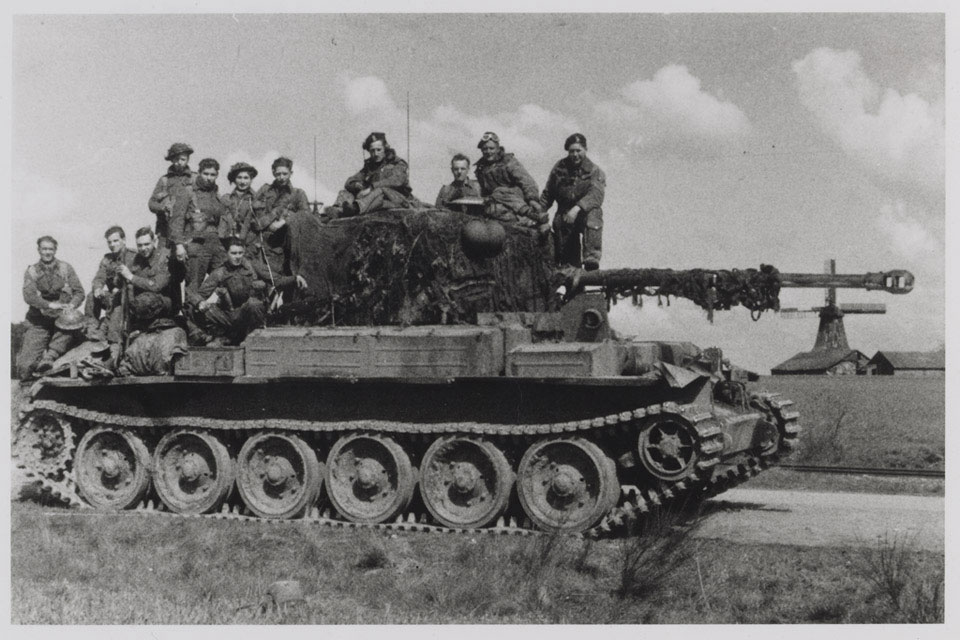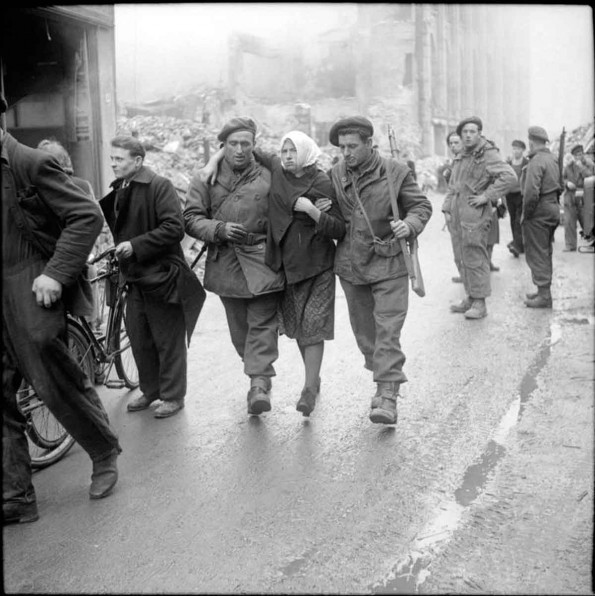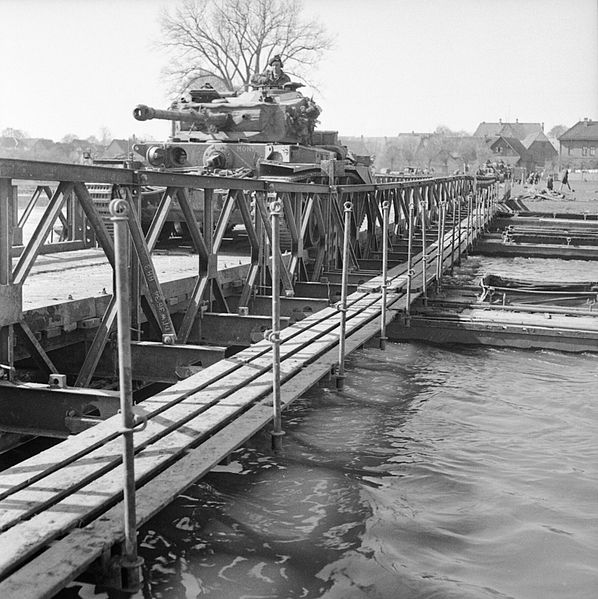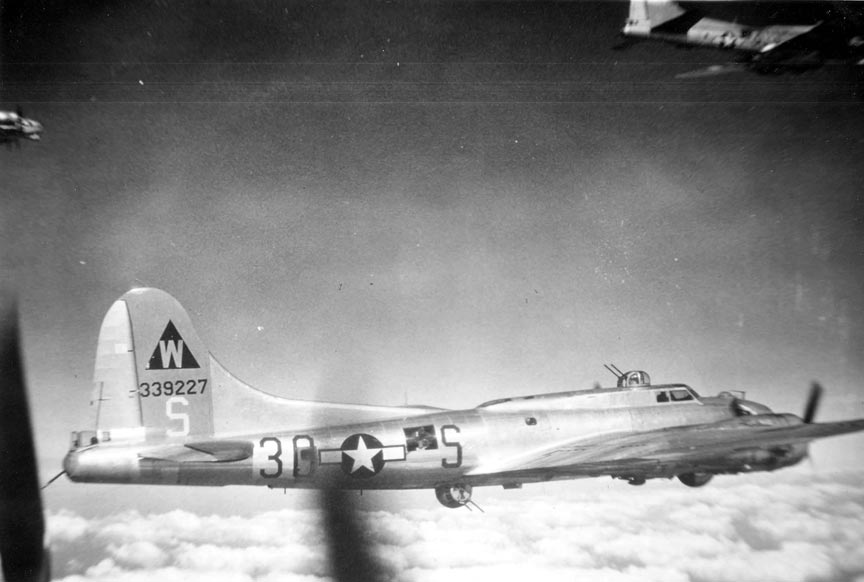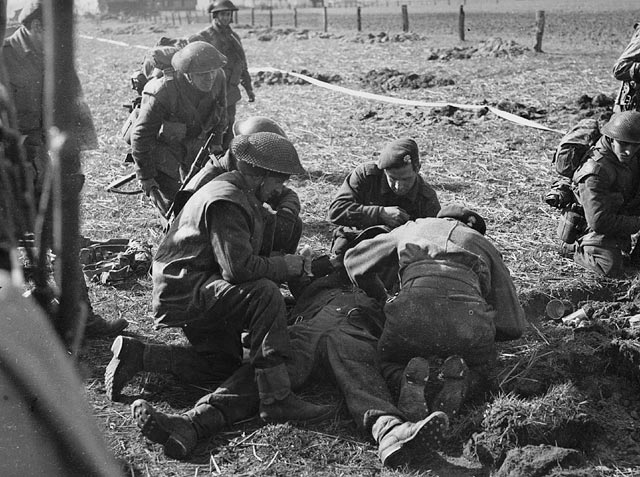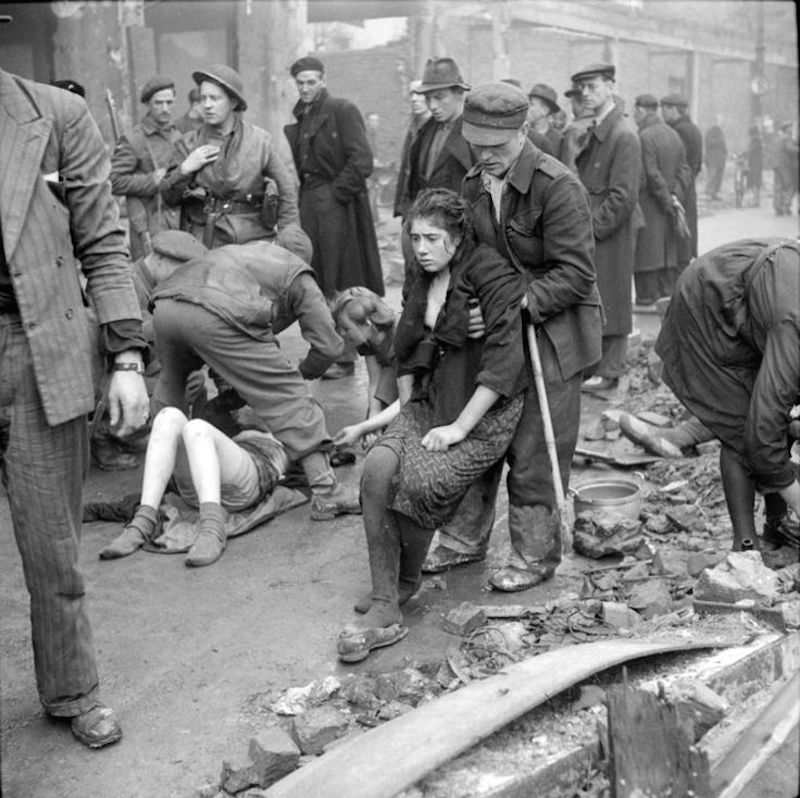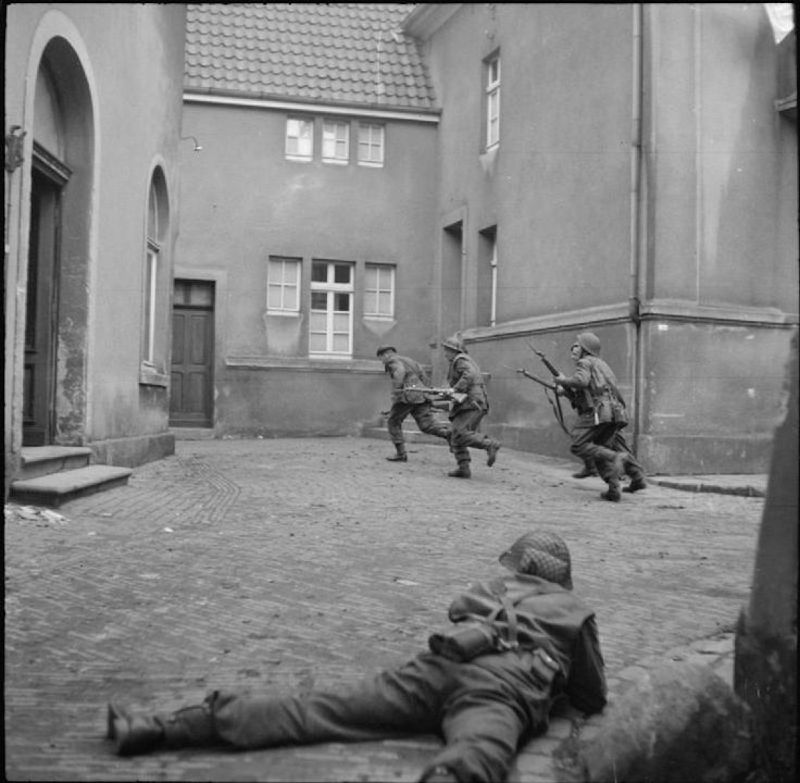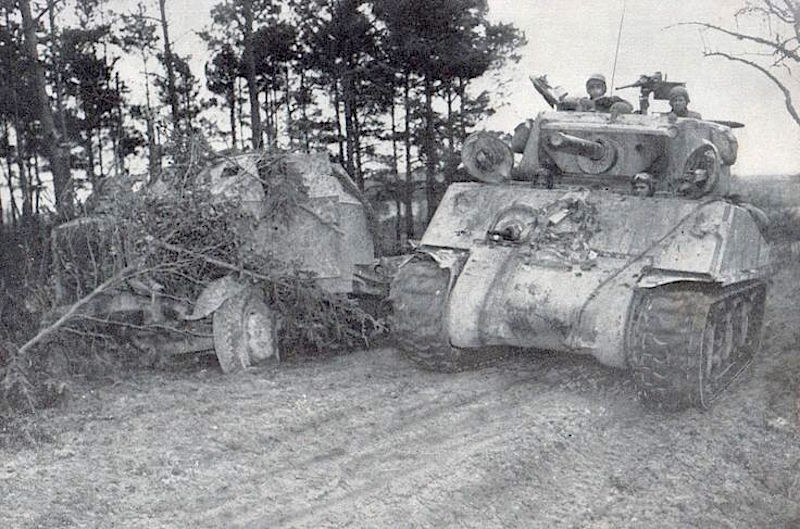Air Operations, CBI
BURMA- 95 10th Air Force fighter-bombers attack numerous targets across central Burma.
- 4 308th Heavy Bomb Group B-24s attack port facilities at Bakli Bay, Hainan, Haiphong, French Indochina, and Samah Bay, Hainan.
- 14 341st Medium Bomb Group B-25s attack targets of opportunity.
- 24 14th Air Force P-51s attack road, rail, and river traffic in the Yellow River area.
- Due to bad weather, 17 38th Medium Bomb Group B-25s dispatched against a large convoy in the South China Sea are unable to locate the ships, and the convoy soon sails beyond range of American land-based aircraft.
- 8 449th Fighter Squadron P-38s attack targets of opportunity around Dien Bien Phu and Nam Hon.
Air Operations, Europe
Mosquitoes raid Berlin for the first time from a continental base. French paratroopers are dropped north of the Zuider Zee. US bombers make wide-ranging attacks on German airfields and railways.
RAF BOMBER COMMANDDaylight Ops:
- 15 Lancasters of No. 617 Squadron and 2 Mosquitos of No. 5 Group carry out an accurate attack on ships at Ijmuiden.
- There are no losses.
- 175 Lancasters and 11 Mosquitos of No. 5 Group attack the benzol plant at Molbis, near Leipzig. The weather is clear and the bombing is so effective that all production at the plant ceases.
- There are no losses.
- There are 14 Mosquito patrols and 6 RCM sorties.
- There are no losses.
GERMANY:
- 1,261 8th Air Force B-17s and B-24s attack numerous airfields, ordnance depots, marshalling yards, and several industrial sites. In the last major effort by Luftwaffe fighters to stem a bombing attack over Germany, 17 heavy bombers are lost--including at least 5 3rd Air Division B-17s that are intentionally rammed by aircraft from a special Luftwaffe unit--as are 5 of 830 VIII Fighter Command escorts.
GERMANY:
- 268 9th Air Division bombers attack two marshalling yards and two defended towns.
- 8th and 9th Air Force fighter pilots down 82 Luftwaffe aircraft between 0830 and 1800 hours.
ITALY:
- 12th Air Force medium bombers are grounded by bad weather, but a small number of XXII TAC P-47s attack an oilfield at Montechino, ammo dumps, and communications targets.
- During the night, XXII TAC A-20s and A-26s attack dumps and German Army command posts.
AUSTRIA:
- A small number of 15th Air Force heavy bombers attack marshalling yards at three locations.
- More than 500 15th Air Force heavy bombers dispatched atainst bridges and other targets in Austria and northern Italy are recalled because of bad weather, but a small number are able to attack two rail bridges and a road bridge in northern Italy.
Air Operations, Formosa
Due to bad weather over their assigned targets, V Bomber Command B-24s and V Fighter Command P-38s attack various targets of opportunity.
[Air Operations, Japan
- 153 of 194 313th and 314th Very Heavy Bomb wing B-29s dispatched attack an aircraft plant in Nagoya. 101 of 107 73rd Very Heavy Bomb Wing B-29s dispatched attack an aircraft plant in Tokyo. 31 B-29s attack various targets of opportunity and last resort.
- 5 B-29s are lost.
- This is the first mission to Japan to be escorted by VII Fighter Command P-51s (91 in this case) based on Iwo Jima.
- The VII Fighter Command’s 15th Fighter Group, which opposed Japanese Navy aircraft at Pearl Harbor on December 7, 1941, mounts its first bomber-escort mission of the war from its new base at Iwo Jima. The group’s P-51 pilots earn a Distinguished Unit Citation when they down a total of 19 Japanese airplanes while escorting 20th Air Force B-29s against an aircraft factory near Tokyo. Several 21st Fighter Group P-51 pilots who also participate in the escort mission down 7 additional Japanese aircraft.
Air Operations, Malaya
FEAF B-24s attack the airfield at Bima.
[Air Operations, Pacific
107(108?) Iwo-based P-51 Mustangs escort B-29s to Tokyo. They are the first US land-based fighters to reach mainland Japan.
[Air Operations, Philippines
- FEAF B-24s and 24 494th Heavy Bomb Group B-24s attack Bunawan.
- FEAF B-24s and XIII Fighter Command P-38s attack Jolo Island.
- V Fighter Command fighter-bombers complete more than 130 effective sorties in the northern Philippines.
Air Operations, Ryukyus
- Ending what turns out to be the Combined Fleet’s final sally of the war—known as the Battle of the East China Sea—Task Force 58 carrier aircraft intercept and sink the heavy battleship Yamato, a light cruiser, and 4 of 8 accompanying destroyers just south of Kyushu.
- US Navy carrier aircraft support US 10th Army ground forces on Okinawa.
- During an attack by kamikazes against Task Force 58, US Navy fighter pilots and ships’ gunners down 54 Japanese aircraft against a loss of 10 fighters, but a kamikaze damages the fleet carrier USS Hancock. Also, 2 US radar picket destroyers are severely damaged by kamikaze hits.
- In all through the day, US carrier-based F6Fs, F4Us, and FMs down 48 Japanese aircraft in the area.
- VMF-221 carrier-based F4Us down a D4Y 'Judy' dive bomber off Kikai Shima at 0639 hours, 5 N1K 'Rex' fighters between Okinawa and Kyushu at 0800 hours, and a P1Y 'Galaxy' bomber north of Okinawa at 1530 hours.
- Early in the afternoon, as VMF-311 is being launched from the escort carriers USS Breton and USS Sitkoh Bay, the latter ship is attacked by a Ki-48 'Lily' bomber kamikaze. 5 VMF-311 F4Us covering the launch down the Ki-48 within 50 yards of the ship, making the first use in combat of 20mm wing cannon mounted in F4Us. Later, at 1530 hours, a VMF-311 F4U based at Yontan Field on Okinawa shares with a VMF-221 carrier-based F4U in the downing of a P1Y 'Galaxy' bomber 100 miles north of Okinawa. This is first land-based aerial victory of the Ryukyus campaign.
Battle of the Atlantic
The German submarine U-857 is sunk by the US destroyer escort Gustafson (DE-182) off Cape Cod, Mass.
| Class | Type IXC/40 |
| CO | Kapitänleutnant Rudolf Premauer |
| Location | East Coast of USA, off Cape Cod |
| Cause | Depth charge |
| Casualties | 59 |
| Survivors | None |
Battle of the East China Sea
Despite Japanese attempts to deceive the Americans by diversions and decoys the Japanese 2nd Fleet is sighted by the American submarine Hackleback (SS-295) in the Bungo Strait, which separated Kyushu from Shikoku. The planes from Task Force 58 intercept the Japanese fleet. Virtually without air cover, the Japanese ships are attacked by hundreds of American aircraft at 12:38p.m., by a second wave at 1:30p.m. and by further waves until after 2:00p.m. The cruiser Yahagi, hit by bombs and torpedoes, is the first to sink. At 2:23p.m., after 3 hours of bombing and torpedo attacks, hit by 5 torpedoes and by countless bombs, the great Yamato goes down with only 269 survivors from the 3,292-man crew. 4 Japanese destroyers are also sunk and 2 damaged. Of 376 American aircraft taking part in the operation, only 10 are lost.
Burma
British 14th Army forces isolate a large Japanese force between Mandalay and Meiktila.
[Eastern Front
Units of the 3rd Ukraine Front penetrate into the southern districts of Vienna, where there is savage house-to-house fighting. The German 8th Army, now withdrawn from Hungary, is engaged in the defense south of Vienna with the 2nd Panzer Army and the 6th SS Panzer Army; the latter repels a Russian thrust in the direction of St Pölten. The German Army Group Center continues its counterattacks against the 2nd and 4th Ukraine Fronts in Czechoslovakia.
At Königsberg, the German 4th Army has to retire about a mile under Russian pressure; the Russians take 130 scattered posts and strongpoints. Senior German officers suggest that the army should retire to the west by way of the Samland peninsula while it is still possible, but Gen Friedrich-Wilhelm Müller forbids it.
In Yugoslavia, Army Group E evacuates Sarajevo. There is also fighting in Dalmatia in the Karlopag-Gospic area, from which the Germans manage to fight their way out.[MORE]
[Okinawa
The 6th Marine Div reaches the line Nago-Taira, at the base of the Motobu peninsula. The XXIV Corps in the south is still severely engaged by the Japanese in front of their positions on the Shuri line.
In the waters off Okinawa Japanese suicide aircraft resume their attacks, damaging the aircraft carrier Hancock (CV-19), the battleship Maryland (BB-46), the destroyer Longshaw (DD-559) and the destroyer escort Wesson (DE-184). Other ships damaged in the day-s action include the motor minesweeper YMS-81 by a kamikaze, the motor minesweeper YMS-103 by a mine, the motor minesweeper YMS-427 by coastal gunfire, the attack transport Audrain (APA-59) by friendly fire, the landing craft LST-698 by grounding and LST-890 in a collision.
[Pacific
- US carrier-based aircraft sink several Japanese ships in the East China Sea including the battleship Yamato, the light cruiser Yahagi and the destroyers Asashimo, Hamakaze, Isokaze and Kasumi.
- The US submarine Tirante (SS-420) sinks the Japanese auxiliary submarine chaser Tama Maru 10 miles east of Shokokusanto, southwest of Korea.
- A mine laid by USAAF B-29 sinks the Japanese merchant cargo ship Hatsukari Maru off Wakamatsu harbor.
- The Japanese light cruiser Isuzu, transporting troops from Koepanbg, Timor to Surabaya, is sunk by the US submarines Gabilan (SS-252) and Charr (SS-328) off Celebes, Netherlands East Indies.
Philippines
On Luzon in the US I Corps sector, after air and artillery preparations, units of the 32nd Div launch a heavy attack against the Japanese positions in the Salacsac Pass area. The 25th Div begins the encirclement of Kapintalan. The XIV Corps is ordered to advance on Mauban and Atimonan, on Lamon Bay, and thence into the Bicol peninsula.
[Western Front
The VIII Corps, British 2nd Army, succeeds in establishing a bridgehead over the Weser River in the Minden-Stolzenau area and pushes on from there toward the Leine. In the US 9th Army sector, the 84th Div, XIII Corps, completes the crossing of the Weser and extends its bridgehead. Units of the XVI Corps continue their advance toward the Rur River and south across the Ems and Rhine-Herne canals, between Gelsenkirchen and Essen. The XVIII Airborne Corps continues its offensive against the Ruhr pocket, together with the III Corps, US 1st Army. The VII Corps reaches the Weser, over which all the bridges have been destroyed.
In the US 7th Army sector, the 14th(?) Div, XV Corps, captures Neustadt, on the Saal River.
[Images from April 7, 1945
|
|
|
|
|
|
|
|
